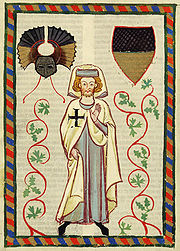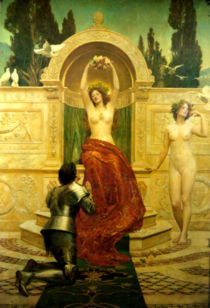
Tannhäuser
Encyclopedia

Germany
Germany , officially the Federal Republic of Germany , is a federal parliamentary republic in Europe. The country consists of 16 states while the capital and largest city is Berlin. Germany covers an area of 357,021 km2 and has a largely temperate seasonal climate...
Minnesänger
Minnesang
Minnesang was the tradition of lyric and song writing in Germany which flourished in the 12th century and continued into the 14th century. People who wrote and performed Minnesang are known as Minnesingers . The name derives from the word minne, Middle High German for love which was their main...
and poet
Poet
A poet is a person who writes poetry. A poet's work can be literal, meaning that his work is derived from a specific event, or metaphorical, meaning that his work can take on many meanings and forms. Poets have existed since antiquity, in nearly all languages, and have produced works that vary...
. Historically, his biography is obscure beyond the poetry, which dates between 1245 and 1265. Socially, he presumed familial lineage with the old nobles
Nobility
Nobility is a social class which possesses more acknowledged privileges or eminence than members of most other classes in a society, membership therein typically being hereditary. The privileges associated with nobility may constitute substantial advantages over or relative to non-nobles, or may be...
, the Lords of Thannhausen
Lords of Thannhausen
von Thannhausen is an old and still existing German aristocratic family with the rank of Freiherr . Their residence is in the municipality of Tannhausen ....
, residents in their castle at Tannhausen
Tannhausen
Tannhausen is a municipality in the German state of Baden-Württemberg, in Ostalbkreis district.Tannhausen is located approx. east of Ellwangen at the edge of the Nördlinger Ries in Swabian Wuerttemberg close to the border of the franconian part of Bavaria, where the administrative districts of...
, near Ellwangen
Ellwangen
Ellwangen an der Jagst, officially Ellwangen , in common use simply Ellwangen is a town in the district of Ostalbkreis in the east of Baden-Württemberg in Germany...
and Dinkelsbühl
Dinkelsbühl
Dinkelsbühl is a historic city in Bavaria, Germany and a former Free imperial city of the Holy Roman Empire. Now it belongs to the district of Ansbach, north of Aalen.-History:...
; moreover, the historical Tannhausen castle, is at Neumarkt in der Oberpfalz
Neumarkt in der Oberpfalz
Neumarkt in der Oberpfalz is the capital of the Neumarkt district in the administrative region of the Upper Palatinate, in Bavaria, Germany. With a population of about 40,000, Neumarkt is the seat of various projects, and acts as the economic and cultural center of the western Upper Palatinate,...
.
Tannhäuser was an active courtier
Courtier
A courtier is a person who is often in attendance at the court of a king or other royal personage. Historically the court was the centre of government as well as the residence of the monarch, and social and political life were often completely mixed together...
at the court of Frederick II of Austria (1230–1246), and the Codex Manesse
Codex Manesse
The Codex Manesse, Manesse Codex, or Große Heidelberger Liederhandschrift is a Liederhandschrift , the single most comprehensive source of Middle High German Minnesang poetry, written and illustrated between ca. 1304 when the main part was completed, and ca...
(1340) depicts him clad in the Teutonic Order habit, suggesting he might have fought the Fifth Crusade
Fifth Crusade
The Fifth Crusade was an attempt to reacquire Jerusalem and the rest of the Holy Land by first conquering the powerful Ayyubid state in Egypt....
(1213–21). As literature, Tannhäuser’s poems parody
Parody
A parody , in current usage, is an imitative work created to mock, comment on, or trivialise an original work, its subject, author, style, or some other target, by means of humorous, satiric or ironic imitation...
the traditional genre, because he was a proponent of the leich
Lai
A lai is a lyrical, narrative poem written in octosyllabic couplets that often deals with tales of adventure and romance.Lais were mainly composed in France and Germany, during the 13th and 14th centuries. A Provençal term for a similar kind of poem is descort.The English term lay is a...
(lai) style of poetry; however, the Bußlied (Poem on Atonement) is unusual, given the eroticism of the remaining Codex Manesse.
In legend

Venusberg (mythology)
Venusberg or Hörselberg is the name of a mythical mountain in Germany situated between Gotha and Eisenach and celebrated in German poetry. Caverns in the mountain housed the court of Venus, goddess of love which was supposed to be perfectly hidden from mortal men: to enter the Venusberg was to...
, the subterranean home of Venus, and spent a year there worshipping the goddess.
After leaving the Venusberg, Tannhäuser is filled with remorse, and travels to Rome
Rome
Rome is the capital of Italy and the country's largest and most populated city and comune, with over 2.7 million residents in . The city is located in the central-western portion of the Italian Peninsula, on the Tiber River within the Lazio region of Italy.Rome's history spans two and a half...
to ask Pope Urban IV
Pope Urban IV
Pope Urban IV , born Jacques Pantaléon, was Pope, from 1261 to 1264. He was not a cardinal, and there have been several Popes since him who have not been Cardinals, including Urban V and Urban VI.-Biography:...
if it is possible to be absolved of his sins. Urban replies that forgiveness is as impossible as it would be for his papal staff to blossom. Three days after Tannhäuser's departure Urban's staff blooms with flowers; messengers are sent to retrieve the knight, but he has already returned to Venusberg, never to be seen again.
The legend has been interpreted as a traditional folk tale which has been subject to Christianization
Christianization
The historical phenomenon of Christianization is the conversion of individuals to Christianity or the conversion of entire peoples at once...
where the familiar story of the seduction of a human being by an elf or fairy leads to the delights of the fairy-realm but later the longing for his earthly home. His desire is granted, but he is not happy, and in the end returns to the fairy-land.
The legend was made famous in modern times through Richard Wagner
Richard Wagner
Wilhelm Richard Wagner was a German composer, conductor, theatre director, philosopher, music theorist, poet, essayist and writer primarily known for his operas...
's three-act opera Tannhäuser
Tannhäuser (opera)
Tannhäuser is an opera in three acts, music and text by Richard Wagner, based on the two German legends of Tannhäuser and the song contest at Wartburg...
, completed in 1845. Aubrey Beardsley
Aubrey Beardsley
Aubrey Vincent Beardsley was an English illustrator and author. His drawings, done in black ink and influenced by the style of Japanese woodcuts, emphasized the grotesque, the decadent, and the erotic. He was a leading figure in the Aesthetic movement which also included Oscar Wilde and James A....
started to write an erotic treatment of the legend which was never to be finished due to his illness; the first parts of it were published in The Savoy
The Savoy (periodical)
This article is about the former British magazine, for other uses, see Savoy The Savoy was a magazine of literature, art, and criticism published in 1896 in London. It featured work by authors such as W. B. Yeats, Max Beerbohm, Joseph Conrad, and Aubrey Beardsley. Only eight issues of the magazine...
and later issued in book form by Leonard Smithers
Leonard Smithers
Leonard Smithers was a London publisher associated with the Decadent movement. Born in Sheffield, he worked as a solicitor, qualifying in 1884, and became friendly with the explorer and orientalist Sir Richard Francis Burton. He published Burton's translation of the Book of One Thousand and One...
with the title Under the Hill
Under the Hill
Under the Hill is an unfinished erotic novel by Aubrey Beardsley, based on the legend of Tannhäuser. The first parts of it were published in The Savoy and later issued in book form by Leonard Smithers...
. In 1907, the original manuscript was published and entitled The Story of Venus and Tannhäuser.
Other references
Aleister CrowleyAleister Crowley
Aleister Crowley , born Edward Alexander Crowley, and also known as both Frater Perdurabo and The Great Beast, was an influential English occultist, astrologer, mystic and ceremonial magician, responsible for founding the religious philosophy of Thelema. He was also successful in various other...
wrote a play called Tannhauser which follows the character Tannhauser and the infamous Venus.
English Poet Algernon Charles Swinburne
Algernon Charles Swinburne
Algernon Charles Swinburne was an English poet, playwright, novelist, and critic. He invented the roundel form, wrote several novels, and contributed to the famous Eleventh Edition of the Encyclopaedia Britannica...
cites a passage of one version of the Tannhäuser legend in the epigraph to his "Laus Veneris" (the praise of Venus).
H.G. Wells' Sleeper watches an adaption in The Sleeper Awakes (1901).
Author Philip José Farmer
Philip José Farmer
Philip José Farmer was an American author, principally known for his award-winning science fiction and fantasy novels and short stories....
references Tannhäuser and Venusberg in the 1967 sci-fi novella
Novella
A novella is a written, fictional, prose narrative usually longer than a novelette but shorter than a novel. The Science Fiction and Fantasy Writers of America Nebula Awards for science fiction define the novella as having a word count between 17,500 and 40,000...
Riders of the Purple Wage
Riders of the Purple Wage
Riders of the Purple Wage is a science fiction novella by Philip José Farmer. It appeared in Dangerous Visions, the famous New Wave science fiction anthology compiled by Harlan Ellison, in 1967, and won the Hugo Award for best novella in 1968, jointly with Weyr Search by Anne McCaffrey.-Title:The...
.
The plot of Neil Gaiman
Neil Gaiman
Neil Richard Gaiman born 10 November 1960)is an English author of short fiction, novels, comic books, graphic novels, audio theatre and films. His notable works include the comic book series The Sandman and novels Stardust, American Gods, Coraline, and The Graveyard Book...
's story Neverwhere
Neverwhere
Neverwhere is an urban fantasy television series by Neil Gaiman that first aired in 1996 on BBC Two. The series is set in "London Below", a magical realm coexisting with the more familiar London, referred to as "London Above". It was devised by Neil Gaiman and Lenny Henry, and directed by Dewi...
broadly mirrors the Tannhauser myth.
In Philip Reeve
Philip Reeve
Philip Reeve is a British author and illustrator. He presently lives on Dartmoor with his wife Sarah and their son Samuel.-Biography:...
's Mortal Engines
Mortal Engines
Mortal Engines is the first of four novels in Philip Reeve's quartet of the same name, which is also known as the Hungry City Chronicles in the United States...
series of books, there is a range of volcanoes named the Tannhäusers.
In Blade Runner
Blade Runner
Blade Runner is a 1982 American science fiction film directed by Ridley Scott and starring Harrison Ford, Rutger Hauer, and Sean Young. The screenplay, written by Hampton Fancher and David Peoples, is loosely based on the novel Do Androids Dream of Electric Sheep? by Philip K...
replicant
Replicant
A replicant is a bioengineered or biorobotic being created in the film Blade Runner . The Nexus series—genetically designed by the Tyrell Corporation—are virtually identical to an adult human, but have superior strength, agility, and variable intelligence depending on the model...
Roy Batty evoked it as he dies, "I watched C-beams glitter in the dark near the Tannhauser Gate
Tannhauser Gate
Tears in rain is the final soliloquy of the android Roy Batty in the movie Blade Runner. It is much quoted and has been described as "perhaps the most moving death soliloquy in cinematic history"...
. All those moments will be lost in time... like tears in rain... Time to die".

